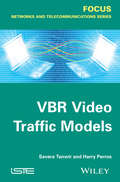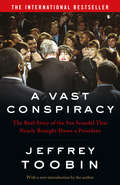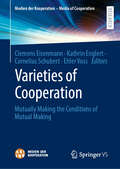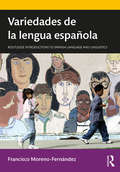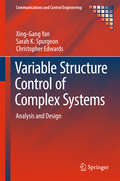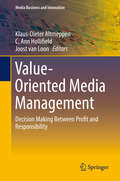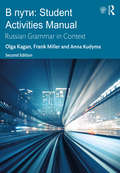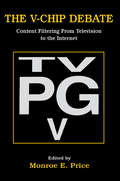- Table View
- List View
VBR Video Traffic Models
by Savera Tanwir Harry G. PerrosThere has been a phenomenal growth in video applications over the past few years. An accurate traffic model of Variable Bit Rate (VBR) video is necessary for performance evaluation of a network design and for generating synthetic traffic that can be used for benchmarking a network. A large number of models for VBR video traffic have been proposed in the literature for different types of video in the past 20 years. Here, the authors have classified and surveyed these models and have also evaluated the models for H.264 AVC and MVC encoded video and discussed their findings.
A Vast Conspiracy: The Real Story Of The Sex Scandal That Nearly Brought Down A President
by Jeffrey ToobinThe International Bestseller The definitive account of the Clinton-Lewinsky sex scandals, A Vast Conspiracy casts an insightful eye over the extraordinary ordeal that nearly brought down a president.
Varieties of Cooperation: Mutually Making the Conditions of Mutual Making (Medien der Kooperation – Media of Cooperation)
by Clemens Eisenmann Kathrin Englert Cornelius Schubert Ehler VossThis volume conceives cooperation in broad terms as any form of mutual making, in which goals, means, and procedures are seen as ongoing accomplishments. From the exchanges of goods or information, to the interactions between bodies or organizations, and the coordination between colleagues, competitors, friends or foes. Mutually making the conditions of mutual making entails translating heterogeneous interests, negotiating conflicting values and articulating distributed activities. On the one hand, the contributions cover different notions and concepts of cooperation in diverse fields of study: from the mundane cooperation of everyday life to collective endeavors within specific domains. On the other hand, the contributions share a focus on the practices of making cooperation possible through cooperatively creating the conditions for cooperation itself. Seeing cooperative media both as a condition and consequence of cooperation, the volume sheds light on a general feature of media, technologies and instruments that both enable and constrain the collaboration between heterogeneous social worlds, with and without consensus. Chapter 7 “The Passport as a Medium of Movement” is available open access under a Creative Commons Attribution 4.0 International License via SpringerLink.
Variedades de la lengua española
by Francisco Moreno-FernándezVariedades de la lengua española ofrece un panorama general de la variación dialectal y sociolingüística en el espacio hispanohablante, presentado por uno de los más prestigiosos expertos en la materia. La lectura de este manual permitirá familiarizarse con los rasgos que distinguen las diferentes variedades geográficas del español, con una comprensión adicional de las causas históricas y políticas de sus diferencias y de sus implicaciones sociales. Cada capítulo incluye sugerencias de lecturas complementarias y propone temas de debate e investigación, así como un glosario que explica la terminología algo más especializada. Complementariamente, el texto remite a materiales audiovisuales disponibles en la red que permiten una aproximación más directa a las variedades del español. Estas páginas son de interés tanto para los hispanohablantes nativos como para los no nativos interesados por la diversidad dialectal. Asimismo, esta obra puede servir como texto primario, de apoyo o complementario para los estudiantes, el profesorado y los hispanistas interesados por el conocimiento de las variedades geográficas y sociales de la lengua española.
Variedades de la lengua española
by Francisco Moreno-FernándezVariedades de la lengua española ofrece un panorama general de la variación dialectal y sociolingüística en el espacio hispanohablante, presentado por uno de los más prestigiosos expertos en la materia. La lectura de este manual permitirá familiarizarse con los rasgos que distinguen las diferentes variedades geográficas del español, con una comprensión adicional de las causas históricas y políticas de sus diferencias y de sus implicaciones sociales. Cada capítulo incluye sugerencias de lecturas complementarias y propone temas de debate e investigación, así como un glosario que explica la terminología algo más especializada. Complementariamente, el texto remite a materiales audiovisuales disponibles en la red que permiten una aproximación más directa a las variedades del español. Estas páginas son de interés tanto para los hispanohablantes nativos como para los no nativos interesados por la diversidad dialectal. Asimismo, esta obra puede servir como texto primario, de apoyo o complementario para los estudiantes, el profesorado y los hispanistas interesados por el conocimiento de las variedades geográficas y sociales de la lengua española.
Variational Methods for Machine Learning with Applications to Deep Networks
by Lucas Pinheiro Cinelli Matheus Araújo Marins Eduardo Antônio Barros da Silva Sérgio Lima NettoThis book provides a straightforward look at the concepts, algorithms and advantages of Bayesian Deep Learning and Deep Generative Models. Starting from the model-based approach to Machine Learning, the authors motivate Probabilistic Graphical Models and show how Bayesian inference naturally lends itself to this framework. The authors present detailed explanations of the main modern algorithms on variational approximations for Bayesian inference in neural networks. Each algorithm of this selected set develops a distinct aspect of the theory. The book builds from the ground-up well-known deep generative models, such as Variational Autoencoder and subsequent theoretical developments. By also exposing the main issues of the algorithms together with different methods to mitigate such issues, the book supplies the necessary knowledge on generative models for the reader to handle a wide range of data types: sequential or not, continuous or not, labelled or not. The book is self-contained, promptly covering all necessary theory so that the reader does not have to search for additional information elsewhere. Offers a concise self-contained resource, covering the basic concepts to the algorithms for Bayesian Deep Learning;Presents Statistical Inference concepts, offering a set of elucidative examples, practical aspects, and pseudo-codes;Every chapter includes hands-on examples and exercises and a website features lecture slides, additional examples, and other support material.
The Variational Bayes Method in Signal Processing (Signals and Communication Technology)
by Václav Šmídl Anthony QuinnThe Variation Theory of Comparative Literature
by Shunqing CaoSeeing the restrictions of former studies in Comparative Literature and aiming to amend these deficiencies, the author of this book mainly discusses the major theoretical significance and academic value of the Variation Theory in the whole process of the development of Comparative Literature in the world. In China the seminal comparative study of literature among different cultures can be dated back to ancient China, while the founding of comparative literature as a distinct academic discipline has to be largely owing to the influence of the West. The modern Chinese study of comparative literature formed its uniqueness under Western influence. The direct influence of the translation of western theories into China is remarkable. However, in the course of translation and reception of Western theories, Chinese comparatists and intellectuals have been encountering various problems, and solving them with an alternative method accordingly different from the traditional methods proposed by the French School and the American School. Therefore, in this book, modern Chinese study of comparative literature is put in a historical context with regard to the theoretical issue of the discipline in China through the entire 20th century. At present, many scholars in China and in other countries agree that, with the influence study proposed by the French School and the study of analogy advocated by the American School, the entire theoretical system of Comparative Literature is well built. However, when the comparative study of literature between East and West is concerned, the theory of Comparative Literature is far from perfect. It is not only because many problems still exist, but there are significant defects in their theoretical bases respectively. Many researches have proven that even with the influence study and the study of analogy, we still can not solve many problems in the practice of studies in comparative literature. This does not mean that we have no respect for the contributions of the French School and the American School; we just want to attach importance to literary variations, which is a phenomenon that has long been neglected. The purpose of putting forward the Variation Theory in Comparative Literature is to provide new perspectives, new methods and new theory to the study of comparative literature, which may be a major breakthrough in the international arena of Comparative Literature. The neglect of literary variation is mainly because all the previous theories about comparative literature start off in search of similarities but not differences. Accordingly, in 1990s heterogeneity as a premise of comparability was put forward. And later, the variation theory was further advanced. It is not only the important phenomenon in literary communication, but also the most valuable research object in Comparative Literature. Still, it will be an important path to cultural innovation. The Variation Theory may make up the major flaws of theories by both French school and the American School since it focus on heterogeneity and variability in cross-cultural literary events, especially the ones of inter-civilization which will be a new course for comparative literature. Throughout the history of literature and the history of literary communication, collisions between different civilizations have always been producing new literary events which make the heterogeneity of different civilizations and variability traceable. The higher stage of literary communication may mean dialogue and blend between different cultures. The overarching concerns of this book include different levels of variation in literary communication and the studies of different objects. The introduction begins with a literature review of major achievements made by the French School and the American School with pointing out what they have neglected. The body of the book is divided into three parts. In the first part, Chapter 1 deals with the major contributions of influence study and its weaknesses. The origination of comparative literature in most of European countrie
Variable Valve Timings: Memoirs of a car tragic
by Chris HarrisTyre destruction, power slides and continuous droolingChris Harris has driven more cars than most people could ever dream of. His vast knowledge is legendary. He calls it 'unhinged geekery'. But we call it infectious enthusiasm, adrenaline-fueled escapism and peerless journalistic rigour and integrity.And then there are his famous skills at the wheel, from city cars to rally cars, F1 to vintage, not forgetting the Guinness World Record 3.4km sideways in an electric car.And now for the first time, Harris is going all out with that unhinged geekery, and takes us down the road of his life-long adventure with the automobile - from the Scalextric track to the Nürburgring 24 Hour, via his own formative low-powered Somerset version of The Dukes of Hazard.A highly individual, petrol-soaked life story that's all down to variable valve timings.
Variable Structure Control of Complex Systems: Analysis and Design (Communications and Control Engineering)
by Xing-Gang Yan Sarah K. Spurgeon Christopher EdwardsThis book systematizes recent research work on variable-structure control. It is self-contained, presenting necessary mathematical preliminaries so that the theoretical developments can be easily understood by a broad readership. The text begins with an introduction to the fundamental ideas of variable-structure control pertinent to their application in complex nonlinear systems. In the core of the book, the authors lay out an approach, suitable for a large class of systems, that deals with system uncertainties with nonlinear bounds. Its treatment of complex systems in which limited measurement information is available makes the results developed convenient to implement. Various case-study applications are described, from aerospace, through power systems to river pollution control with supporting simulations to aid the transition from mathematical theory to engineering practicalities. The book addresses systems with nonlinearities, time delays and interconnections and considers issues such as stabilization, observer design, and fault detection and isolation. It makes extensive use of numerical and practical examples to render its ideas more readily absorbed. Variable-Structure Control of Complex Systems will be of interest to academic researchers studying control theory and its application in nonlinear, time-delayed an modular large-scale systems; the robustness of its approach will also be attractive to control engineers working in industries associate with aerospace, electrical and mechanical engineering.
Vanity Fairs: Another View of the Economy of Attention
by Georg FranckThis book offers readers a comprehensive introduction to the economy of attention from the perspective of the basic motive of the pursuit of attention: self-esteem. As a jumping-off point, it states the stark equation at the heart of this economy— that the self-esteem one can afford depends on one’s income of appreciative attention. The information markets in which participants compete to play a role in the consciousness of others are described as ‘vanity fairs’. Since the pursuit of self-esteem is highly effective when it comes to mobilizing human energies, vanity fairs are not just playgrounds of individual passions, but have been utilized by society since time immemorial as markets for particularly challenging demands.Starting with an analysis of the interface that connects the social economy of attention with the intra-psychic economy of self-esteem, the book then examines two main cases in point: modern science and the post-modern media culture. On the one hand we have scientists working for a ‘wage of fame’, who invest their own attention into getting the attention of others. On the other, today’s dominant media have left the sale of information behind to focus solely on the attraction of attention, which is sold as a service to the advertising industry. In each case the use of attention as a means of payment is key to its phenomenal success. But success comes at a price: the dark side of this monetization of attention is a kind of ’climate change’ in the collective mental sphere which threatens the very existence of our social fabric.
The Vanity Fair Diaries: 1983 1992
by Tina Brown'Indiscreet, brilliantly observed, frequently hilarious' Evening Standard'Hang on - it's a wild ride' Meryl StreepIt's 1983. A young Englishwoman arrives in Manhattan on a mission. Summoned in the hope that she can save Condé Nast's troubled new flagship Vanity Fair, Tina Brown is plunged into the maelstrom of competitive New York media. She survives the politics and the intrigue by a simple stratagem: succeeding. Here are the inside stories of the scoops and covers that sold millions: the Reagan kiss, the meltdown of Princess Diana's marriage to Prince Charles, the sensational Annie Leibovitz cover of a gloriously pregnant, naked Demi Moore. Written with dash and verve, the diary is also a sharply observed account of New York and London society. In its cinematic pages the drama, comedy and struggle of raising a family and running an 'it' magazine come to life.
VANET: Vehicular Applications and Inter-Networking Technologies (Intelligent Transport Systems #1)
by Hannes Hartenstein Kenneth LaberteauxThis book provides an invaluable introduction to inter-vehicular communications, demonstrating the networking and communication technologies for reducing fatalities, improving transportation efficiency, and minimising environmental impact. This book addresses the applications and technical aspects of radio-based vehicle-to-vehicle and vehicle-to-infrastructure communication that can be established by short- and medium range communication based on wireless local area network technology (primarily IEEE 802.11). It contains a coherent treatment of the important topics and technologies contributed by leading experts in the field, covering the potential applications for and their requirements on the communications system. The authors cover physical and medium access control layer issues with focus on IEEE 802.11-based systems, and show how many of the applications benefit when information is efficiently disseminated, and the techniques that provide attractive data aggregation (also includes design of the corresponding middleware). The book also considers issues such as IT-security (means and fundamental trade-off between security and privacy), current standardization activities such as IEEE 802.11p, and the IEEE 1609 standard series. Key Features: Covers the state-of-the-art in the field of vehicular inter-networks such as safety and efficiency applications, physical and medium access control layer issues, middleware, and security Shows how vehicular networks differ from other mobile networks and illustrates the idea of vehicle-to-vehicle communications with application scenarios and with current proofs of concept worldwide Addresses current standardization activities such as IEEE 802.11p and the IEEE 1609 standard series Offers a chapter on mobility models and their use for simulation of vehicular inter-networks Provides a coherent treatment of the important topics and technologies contributed by leading academic and industry experts in the field This book provides a reference for professional automotive technologists (OEMS and suppliers), professionals in the area of Intelligent Transportation Systems, and researchers attracted to the field of wireless vehicular communications. Third and fourth year undergraduate and graduate students will also find this book of interest. For additional information please visit http://www.vanetbook.com
Values of German Media Users: 1986 - 2007
by Merja MahrtValues of German media users, 1986-2007 Values have been discussed in connection to the changes brought to the German TV landscape since the introduction of the dual system in 1984. Yet, on such occurrences arguments have rarely, if at all, been based on reliable information about differences in televised values. Nor have values of the audience of channels or genres been considered. This study offers a starting point for such an endeavor, focusing on the role values play for people’s media choices. In a theoretical overview, values are situated in a framework of overlapping spheres that influence people in the adoption of values. Social learning is the main mechanism behind this process of socialization. Values define what is desirable or not and how one should behave in a given situation according to the rules of one’s society. As stable basic traits close to an individual’s personality, values play a part in the building of motives that finally result in behavior. With regard to media, a well-established gratification of media use is the reinforcement of one’s own values and worldviews. Based on the finding that mediated value patterns differ across outlets and types of content, I assume that different values should lead people do prefer different media over others.
Values and Choices in Television Discourse: A View from Both Sides of the Screen
by Roberta Piazza Louann Haarman Anne CabornThe high-pressured, fast-paced environment of television production leaves little time for producers to reflect on how the potentialities of texts and images will be interpreted outside of the immediate broadcast imperatives. This volume brings together the producers and analysts of television in a formal and productive way.
Value-Oriented Media Management: Decision Making Between Profit and Responsibility (Media Business and Innovation)
by Klaus-Dieter Altmeppen C. Ann Hollifield Joost Van LoonIn the light of a rapidly changing media industry with new technologies, actors and advertising models, and the critical role of media in society, this volume highlights the meaning of different values in media companies and media managers’ decisions. It discusses how economic as well as societal values can be equally integrated in media management processes and how such values affect the internal as well as external environment of media companies. The contributions analyze various issues in media management, such as the relationship between quality and audience demand, the role of branding in building values, changes in the value chain, and the impact of deregulation. Further important topics include hypercompetition, mediatization, challenges for media managers and the meaning of corporate social responsibility.
Value-Added Services for Next Generation Networks
by Thierry Van de VeldeIn the NGN world, no truer words are spoken than "the future is now." And the competition in the information networking arena will only intensify in the next 5-10 years. Choosing the correct NGN-VAS strategy now will set your company apart. Value Added Services for Next Generation Networks examines the quest for the real added value in modern commu
Value-Added Services for Next Generation Networks
by Thierry Van de VeldeIn the NGN world, no truer words are spoken than "the future is now." And the competition in the information networking arena will only intensify in the next 5-10 years. Choosing the correct NGN-VAS strategy now will set your company apart. Value Added Services for Next Generation Networks examines the quest for the real added value in modern commu
Valuable Content Marketing: How to Make Quality Content Your Key to Success
by Sonja Jefferson Sharon TantonWINNER: 2016 Marketing Book of the Year; Small Biz Book Awards. From websites, white papers and blogs to tweets, newsletters and video, content is king in the digital world, now more than ever before. Get it right and you have a huge opportunity to connect with clients and customers in ways they appreciate and trust - they'll be knocking at your door wanting to do business with you. Valuable Content Marketing shows you how to create and share the type of information that clients, customers and search engines really want - on your website, using social media and through more traditional methods. Whether you're starting a business or aiming to grow, this book shows you how to get better results from your marketing efforts.Marketing with valuable content really works - this book shows you how to grow your business by raising awareness of your brand, turning prospects into buyers and buyers into long-term fans. This fully revised second edition of Valuable Content Marketing is a clear, practical guide that helps you make sense of marketing in the digital world and learn to enjoy the journey. It includes new ideas and examples, step-by-step action lists, quick tips and goal-driven chapter summaries to make understanding the key concepts easier than ever. Perfect for small-business owners and sales, marketing and branding professionals as well as practitioners in publicity or corporate communications, it provides inspiration from companies of all sizes that have got valuable content marketing right, from small companies like software development from Desynit to household names like HSBC.
Validation of Communications Systems with SDL: The Art of SDL Simulation and Reachability Analysis
by Laurent DoldiValidation of Communications Systems with SDL provides a clear practical guide to validating, by simulation, a telecom system modelled in SDL. SDL, the Specification and Description Language standardised by the International Telecommunication Union (ITU-T), is used to specify and develop complex systems such as GSM, GPRS, UMTS, IEEE 802.11 or Hiperlan. Since the downturn in the telecom industry, validating a system before its implementation has become mandatory to reduce costs. This volume guides you step by step through the validation of a simplified protocol layer, from interactive simulation to proof of properties using reachability analysis combined with observers. Every step is explained, using the two main SDL tools commercially available: ObjectGeode™ and Tau SDL™ Suite, both from Telelogic. Contents: Short tutorial on SDL Presentation of the protocol layer case study Interactive simulation, MSC generation Scripting, automatic non-regression Auto matic validation against MSC, HMSC, etc. Random simulation Exhaustive and bit-state simulation Errors detected and not detected by simulation Other simulator features This book offers you the opportunity to: Learn expert validation techniques and tips Master advanced simulation features of Telelogic ObjectGeode™ and Tau SDL Suite™ Practice 156 hands-on exercises with solutions. The SDL models and scripts used in the exercises can be downloaded from the Web.
Vaadin 7 UI Design By Example: Beginner's Guide
by Alejandro DuarteThis book is a hands-on Beginner's Guide for developers who are new to Vaadin and/or Vaadin UI components. The book will teach readers through examples to use each of the exciting components to build and add various aspects of the user interface to their web apps.If you have experience with the Java language and want to create web applications that look good without having to deal with HTML, XML, and JavaScript, this book is for you. Basic Java programming skills are required, but no web development knowledge is needed at all.
V Puti: Russian Grammar in Context
by Frank Miller Olga Kagan Anna KudymaThis highly successful program assists in the development of all the language skills (listening, speaking, reading and writing) by presenting realistic settings, situations and contexts. It consists of 12 chapters and can be used in an intermediate or advanced Russian course. V Puti offers conversational exercises, various readings (biographies, poems, literature and historical texts) and grammatical explanations and practice. All of these components reinforce Russian culture and history which enable the students to understand the Russian language in context. V Puti: Student Activities Manual is an integral part of the V Puti course. The structure matches the main textbook and provides a wealth of exercises and activities, either for class-use or homework.
V Puti: Russian Grammar in Context
by Frank Miller Olga Kagan Anna KudymaThis highly successful program assists in the development of all the language skills (listening, speaking, reading and writing) by presenting realistic settings, situations and contexts. It consists of 12 chapters and can be used in an intermediate or advanced Russian course. V Puti offers conversational exercises, various readings (biographies, poems, literature and historical texts) and grammatical explanations and practice. All of these components reinforce Russian culture and history which enable the students to understand the Russian language in context. V Puti: Student Activities Manual is an integral part of the V Puti course. The structure matches the main textbook and provides a wealth of exercises and activities, either for class-use or homework.
The V-chip Debate: Content Filtering From Television To the Internet (Routledge Communication Series)
by Monroe E. PriceThe V-chip is a highly significant part of the discussion about whether television (or broadcasting in general) deserves some special attention in terms of its accessibility to children, its particular power to affect conduct, and its invasiveness. But as this notion of filtering and labeling has caught the imagination of the regulator, the legislator, and all those who wish to consider new ways to alter bargaining over imagery in society, the very idea of the V-chip or its equivalent is moving across other technologies, including the Internet. The V-chip issue has also fueled the ongoing debate about violence and sexual practices in society, and how representations on television relate to those practices. Although the initial concept of the V-chip is simple, its flow into the public realm raises so many extraordinary questions that the introduction and production of the chip virtually serves as a case study in problems of law and public policy. The very conceptualization of speech in society is being affected by this issue. Accordingly, the place of the V-chip in this debate is increasingly important; indeed, it may be argued that the V-chip's contribution to legal argumentation may be greater than its ultimate contribution to the relationship between children and imagery. Among the questions the contributors address are: *What research basis is necessary to require a framework for labeling and rating? *What relationship between government and the image-producing industries can be characterized--for constitutional and other reasons--as voluntary as opposed to coercive? *Who should evaluate these images? *To what extent should the evaluation process be centralized and/or distributed? *What assessment is appropriate to evaluate whether the experiment is "successful?" In addition to the V-chip's origin's in Canada and its further evolution in the United States, this book discusses the development of the V-chip and television rating systems in Europe, Australia, and throughout the world. It also includes essays which contrast the very different approaches in Canada and the United States in terms of the role of regulatory agency, industry, and government.
The V-chip Debate: Content Filtering From Television To the Internet (Routledge Communication Series)
by Monroe E. PriceThe V-chip is a highly significant part of the discussion about whether television (or broadcasting in general) deserves some special attention in terms of its accessibility to children, its particular power to affect conduct, and its invasiveness. But as this notion of filtering and labeling has caught the imagination of the regulator, the legislator, and all those who wish to consider new ways to alter bargaining over imagery in society, the very idea of the V-chip or its equivalent is moving across other technologies, including the Internet. The V-chip issue has also fueled the ongoing debate about violence and sexual practices in society, and how representations on television relate to those practices. Although the initial concept of the V-chip is simple, its flow into the public realm raises so many extraordinary questions that the introduction and production of the chip virtually serves as a case study in problems of law and public policy. The very conceptualization of speech in society is being affected by this issue. Accordingly, the place of the V-chip in this debate is increasingly important; indeed, it may be argued that the V-chip's contribution to legal argumentation may be greater than its ultimate contribution to the relationship between children and imagery. Among the questions the contributors address are: *What research basis is necessary to require a framework for labeling and rating? *What relationship between government and the image-producing industries can be characterized--for constitutional and other reasons--as voluntary as opposed to coercive? *Who should evaluate these images? *To what extent should the evaluation process be centralized and/or distributed? *What assessment is appropriate to evaluate whether the experiment is "successful?" In addition to the V-chip's origin's in Canada and its further evolution in the United States, this book discusses the development of the V-chip and television rating systems in Europe, Australia, and throughout the world. It also includes essays which contrast the very different approaches in Canada and the United States in terms of the role of regulatory agency, industry, and government.
